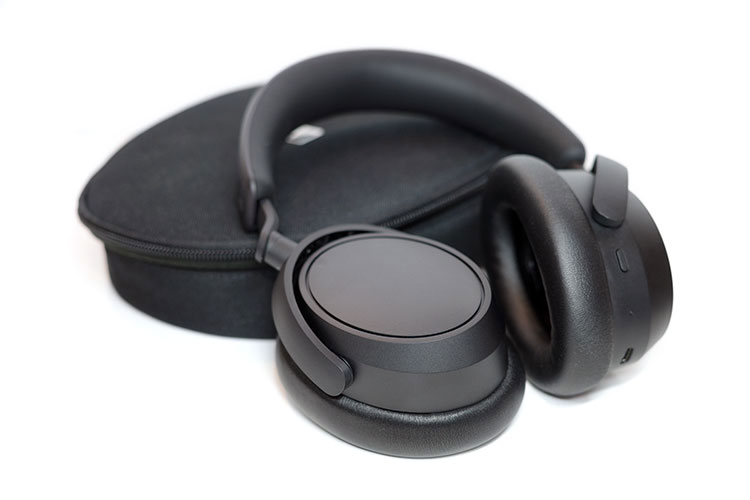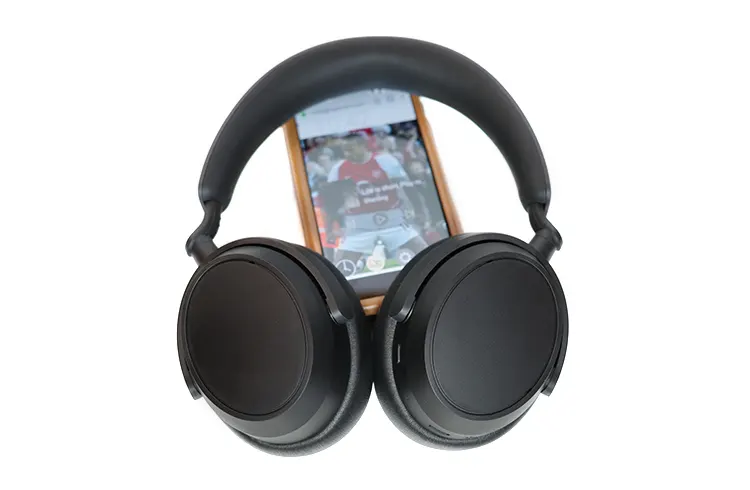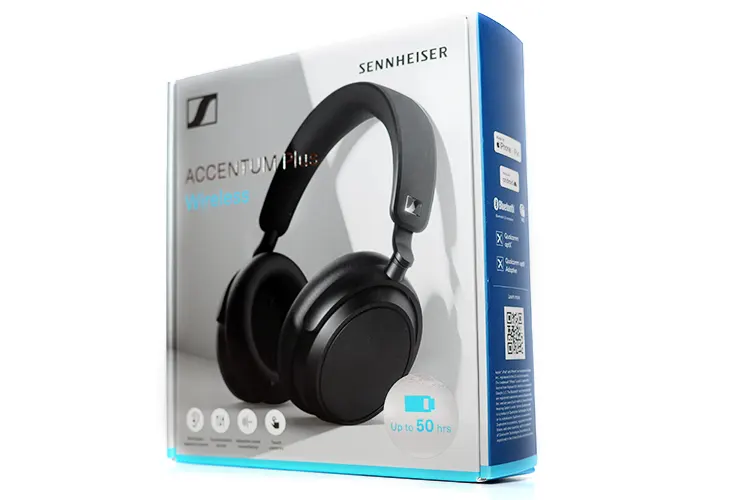Wired Performance
USB-C
A nice trick the MOMENTUM 4 Wireless had is USB-C audio, which raises the sound quality compared to BT, with better detail retrieval, and transient response. Thankfully the same can be said for the ACCENTUM Plus. I used a ddHiFi USB-C to USB-C cable for the following assessment.
Hooking the ACCENTUM Plus up to the Shanling M6 Pro, I found the clarity quite pleasing, with the warmer, richer signature of the Shanling allowed to shine through better than a BT connection.
The Bass reached deeper, with better control via speedy attack and decay; with the midrange pushed slightly forward with better control. The treble notes came across with energy but never became strident until I raised the volume level to unsafe levels.
As an alternative to BT (and the 3.5 connection below), USB-C to USB-C (or USB-A) gives the ACCENTUM Plus another option and one that adds quality to its repertoire.
3.5mm Analog
The ACCENTUM Plus comes with a 3.5mm single-ended jack cable that you can use in wired analog mode.
The level of detail immediately jumped a bit, but the volume needed to be raised significantly to match the BT level I had before the connection. That said, both the volume level on Qobuz and the MBP had plenty of ‘wiggle room’.
Double tapping the right cup similarly activated ANC or transparency mode.
The tightness of notes pervaded the sound, with good clarity and only a little loss in weight. The sound became livelier, but a bit thinner. I found it to be livelier than the original ACCENTUM, but also a bit less rich when compared to the USB-C cable on the regular model.
Just like the regular ACCENTUM, anytime you add a cable, the sound should be better over BT, since you are using an external DAC. As good as BT has gotten, it still falls behind cable options for the most part.
Wireless Stability
Bluetooth 5.2 allows most of the latest codecs up to aptX HD to flow through, but the ACCENTUM Plus still lacks LDAC.
Regardless, the range of wireless connectivity was strong. Leaving my source, I could attain over 22m from my iPhone through obstructions and about 10 meters while using the Cayin N6ii (I again blame the Cayin here, not the headphones).
Even without LDAC, the sound quality was good over the whole distance, with no dropouts until I reached the maximum range noted for each transmitting source.
Select Comparisons
Sennheiser MOMENTUM 4 Wireless
Technical
The ACCENTUM Plus still uses the same 37mm driver as the original, while the MOMENTUM 4 Wireless uses a larger 42mm driver. The MOMENTUM 4 Wireless supports up to AptX Adaptive, just like the ACCENTUM Plus.
Both carry ear cup touch sensitivity and a 3.5mm se cable for wired listening, blurring the line between the two.
The MOMENTUM 4 Wireless ANC is still better, with full immersion when using, whereas the ACCENTUM Plus does not carry as much pure isolating power.
Design
The MOMENTUM 4 Wireless design is extremely well thought out. The selected angles of the headband end up relieving pressure on the top of your head, despite being plastic in the materials used. There is still more padding than the ACCENTUM Plus across the underside, which helps comfort.
The plastic design is thick and weighty, lacking any creaks or squeaks when rotating the ear cups in your hand or applying pressure to the headband area. Metal was not used near the ear cups to keep weight down, thus making the headphones more comfortable.
This is a headphone intended for active users, so we do appreciate the quality of plastics used. The headband arc is aluminum and feels slightly pliable with the ability to bend a bit outward before bouncing back into shape.
The ear pads are circumaural but on the smaller side of “full size” (much like the ACCENTUM Plus). Both ear cups rotate and swivel around enough to allow for a very good fit (and fit into their respective cases).
On the bottom side of the right ear cup, you will find the power button, which doubles as a pairing mode button when long pressed; light indicators of pairing modes and battery life left; the 2.5mm input for wired cable mode; and a USB-C port.
On both ear cups, you’ll find a mesh metal vent for dual microphones just below the grating.
Performance
The bass in the MOMENTUM 4 Wireless falls in a similar vein to the ACCENTUM but is better controlled.
Taut with very good decay makes for a speedier bass response, enhancing the overall quality over the ACCENTUM as well. The ACCENTUM Plus has closed the gap, with that brightness, but this should not be construed as control.
That tighter control makes for a more accurate signature, with a bit less smooth character to the sub-bass.
Conversely, the midrange is now even more laidback and relaxed compared to the ACCENTUM Plus. This allows them to become part of the signature instead of becoming shouty or too far forward.
There is excellent weight to vocals, making the MOMENTUM 4 Wireless one of the more realistic-sounding ANC headphones, too.
The upper mids add energy, not only making the overall character good in detail but leading nicely to the upper end, which is a statement to Sennheiser’s tuning.
When talking about Sennheiser tuning, words often mentioned include clean, crisp, detailed, and accurate. This is what makes the marque sought after in the high-end market.
On the MOMENTUM 4 Wireless, you can easily hear the familial resemblance in the treble region. Melodic, dynamic, and clean counters the relaxed midrange, allowing the “book-ends” of bass and treble to complete the tuning nicely. The ACCENTUM Plus closes this gap nicely, what with the vibrant tonality of the signature.
The MOMENTUM 4 is a very good wireless headphone, with excellent ANC, and touch controls on the right ear cup, which get better with each update to the firmware.
Sennheiser ACCENTUM
Technical
The Sennheiser ACCENTUM is a set of closed-back wireless, (Bluetooth), headphones with additional hybrid ANC capability and Smart Control app integration.
The ACCENTUM uses a 37mm dynamic driver and supports USB-C audio for wired connectivity and a BT 5.2-capable internal chipset for wireless connectivity.
It is capable of receiving and decoding from SBC and AAC up to aptX, and aptX HD codecs. However, there is no LDAC or aptX Adaptive capability currently.
The hybrid ANC technology is either on or in transparency mode through Sennheiser’s Smart Control app (or a double press of the power/pairing button). There is no middle ground.
But, Sennheiser has a history of good ANC quality in their wireless options so it should be worthy of the moniker. ANC will be discussed below but suffice to say it is an interesting take on the inclusion of this technology.
No cable jack is included, only a USB-C charging port so the ACCENTUM is a wireless headphone first and foremost though you can use the USB-C port for digital lossless audio.
Design
The ACCENTUM follows Sennheiser’s subtle and understated look in most of their Bluetooth models. Smaller in size, the unit only folds flat and the cups do not fold up to make the unit more portable.
The cup size is medium-small, and those with larger ears will most likely suffer from the pads lying on their ears. Stuffed with memory foam, the pads are comfortable for moderate use but have no waterproof rating.
The ACCENTUM is made mostly of plastic and the headband carries over in one piece with a memory foam insert underneath for head relief. While the fit and materials are on the budget side, they do follow the market segment.
That padding only goes halfway down the band in a somewhat odd shape while supporting the top of your head. Those with larger heads may find the pad/hard plastic interface could hinder comfort.
Vent slots sit on top of each cup, while two microphone holes sit on the face and side of the right cup; closer to where they are needed.
The tactile buttons control all functions on the right cup, with no swipe gesturing. Those buttons work well, and it becomes intuitive after a short period of use. There is a button for ANC, which is controlled via the app or a double press of the power/pairing button.
Performance
Considering this is oriented for different purposes than more expensive models, you would think that the ACCENTUM might short itself on the sound signature. This is not entirely true and gives a good reference for where the ACCENTUM Plus continued the journey.
Restoring all EQ settings to flat allowed for solid bass down low, with mids pushed forward, but not lifted. The treble notes rode the forward push a bit, but not as much.
Providing good reach, the upper end was rounded off, without much sparkle. Combined, this made for a bookend effect around the richer, livelier midrange.
Where the ACCENTUM went for smooth, the ACCENTUM Plus goes vibrant. Where the ACCENTUM goes for richness, the ACCENTUM Plus goes for a more detail-focused sound. Where the ACCENTUM has USB-C only for wired, the ACCENTUM Plus can do that and 3.5 dedicated listening.
My Verdict
The Sennheiser ACCENTUM was meant to fill a niche in the company’s entry-level wireless headphone lineup. As such, we could reasonably expect it to function well, but not to the level of its more expensive mates. And it did.
Taking notes from that model, and what I believe to be from the highly successful MOMENTUM 4 Wireless, the ACCENTUM Plus adds to the lower-tier original’s base qualities with improved vibrancy in its tuning.
The fit is still an issue for me during longer listening sessions. However, pretty much any “shortcomings” I thought the original had, were corrected with the ACCENTUM Plus including AptX Adaptive, swipe control, a dedicated 3.5 cable, and a case.
Add all of those changes up, and you can understand why the ACCENTUM Plus costs more and should be considered an upgrade to the original.
Sennheiser ACCENTUM Plus Technical Specifications
- Connectivity: Bluetooth 5.2 compliant, class 1, 10 mW (max)
- Transmission frequency/modulation: 2,402 MHz to 2,480 MHz; GFSK, π/4 DQPSK, 8DPSK, π/4 QPSK, 8PSK
- Supported Profiles: A2DP, AVRCP, HFP, HSP, GATT
- Supported codecs: SBC, AAC, aptX™, aptX adaptive™, mSBC, CVSD
- Speaker type/size: 37mm diameter dynamic driver
- Speaker frequency range: 10 Hz to 22 kHz
- Speaker sensitivity: 106 dB SPL (1 kHz / 0 dBFS)
- Speaker THD: <0,3% (1 kHz / 100 dB SPL)
- Speaker impedance: Active: 560 Ohms, Passive: 95 Ohms
- Active Noise Cancellation: Hybrid Adaptive ANC
- Mic principle: MEMS
- Mic frequency range: 50 Hz to 8 kHz
- Mic pick-up pattern: 2 mics, beamforming for noise reduction
- Battery lifespan: Up to 50 hrs music playtime via Bluetooth and with ANC (test condition: iPhone, medium volume level)
- Charging time: Approx. 3.5 hrs for full charge After 10 min charging up to 5 hrs music playtime
- Battery type: Built-in Lithium-Ion rechargeable battery 800 mAh
- Power Supply: 5 V⎓, 700 mA max, USB charging via USB-C socket
- Magnetic field strengthark: 3.0 mT
- Product weight: 0,227 kg
- Dimensions (with feet): Approx. 16,5 x 19,5 x 4,8 (folded flat)
- Dimensions dimension (without feet): Approx. 16,5 x 19,5 x 4,8 (folded flat)





